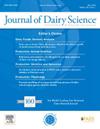Relative merits of offering a milk replacer, glucose-electrolyte, or whey-based diet on the blood composition and health of unweaned calves after transport
IF 3.7
1区 农林科学
Q1 AGRICULTURE, DAIRY & ANIMAL SCIENCE
引用次数: 0
Abstract
The objective of this randomized controlled trial was to assess the relative merits of offering unweaned calves 3 different types of diets to meet energy and water deficits that can occur during journeys. A total of 6 young unweaned male Holstein calves were randomly selected from within 2 body weight ranges (median 48 and 42 kg) from each of 29 loads (total n = 174 calves) transported from an auction market or a collection center to a calf sorting center before transport to a veal unit. The calves were then randomly allocated to one of 3 dietary treatments (n = 58 calves/dietary treatment). They were offered either a milk replacer diet (M), a glucose-electrolyte diet (G) or a whey-based diet with added electrolytes (W). The ability of these diets to provide sufficient nutrient energy to restore vigor, and avoid hypoglycemia and clinical signs of dehydration without increasing the risk of diarrhea was assessed. A clinical assessment of dehydration, health, and vigor was made, and the calves were blood sampled before feeding and at 2 h and 4 h after feeding. The plasma glucose concentration was increased 2 h and 4 h after feeding the M and W diets. The increases in plasma glucose concentration were greater 2 h and 4 h after (1) feeding the M than after the W diet and (2) feeding the M and W diets than after the G diet. Back-transformed means and 95% CI for the ratio of the plasma glucose concentration at 4 h compared with 0 h for the M, G, and W diets were 1.2 mM (CI = 1.21, 1.35), 0.95 mM (CI = 0.92, 0.97), and 1.09 mM (CI = 1.06, 1.14), respectively. We found no effect of diet on the change in serum total protein concentration between before feeding and 2 h and 4 h after feeding. The serum osmolality was lower 2 h after feeding the G diet. The fall in serum osmolality was greater 2 h after feeding the G diet than after feeding the M and W diets. The changes in the serum osmolality between before feeding and 2 h after feeding for the milk replacer, glucose-electrolytes and whey-based diets were −0.68 mOsmol (CI = −3.27, 1.91); −5.23 mOsmol (CI = −7.82, and −2.64); and −0.13 mOsmol (CI = −2.77, 2.51), respectively. The diet offered at the sorting center had no effect on subsequent growth on the veal-rearing farm between arrival and slaughter (milk replacer, 1.22 kg/d [CI = 1.17, 1.28]; glucose-electrolyte diet, 1.23 kg/d [CI = 1.18, 1.28]; whey-based diet 1.28 kg/d [CI = 1.23, 1.33]). The M diet provided the calves with nutrients and water to replace energy and water deficits that had accumulated before arrival at the sorting center, and these dietary benefits were still apparent 4 h after feeding. The benefits of the W diet were similar to those of the M diet, but the M diet was better able to assist the calves in maintaining their plasma glucose concentration 4 h after feeding than the W diet. The G diet had some short-term benefits in providing energy and assistance to the calves to recover from dehydration, as indicated by a decrease in serum osmolality. However, the G diet was clearly inferior to the M and W diets in providing sufficient energy to assist the calves in recovering from the effects of transport and fasting. During the 4 h after feeding, no adverse effects of offering the calves the M or W diets were observed. The benefits of the W diet in replacing energy and water deficits were similar to those of the M diet, but the M diet was better able to assist the calves in maintaining their blood glucose concentration 4 h after feeding than the W diet.
提供代乳品、葡萄糖电解质或乳清日粮对运输后未断奶犊牛的血液成分和健康的相对优点。
这项随机对照试验的目的是评估为未断奶犊牛提供 3 种不同类型的日粮以满足运输途中可能出现的能量和水分缺乏的相对优点。在将犊牛从拍卖市场或收集中心运往小牛分拣中心之前,从 29 批货物(共计 174 头犊牛)中的每批货物(中位数分别为 48 千克和 42 千克)的两个体重范围内随机挑选 6 头未断奶的雄性荷斯坦犊牛。然后将犊牛随机分配到 3 种饮食处理中的一种(n = 58 头犊牛/饮食处理)。这些犊牛分别食用代乳品日粮(M)、葡萄糖电解质日粮(G)或添加电解质的乳清日粮(W)。评估了这些日粮在不增加腹泻风险的情况下提供足够营养能量以恢复活力、避免低血糖和脱水临床症状的能力。对脱水、健康和活力进行临床评估,并在饲喂前、饲喂后 2 小时和 4 小时对犊牛进行血液采样。饲喂 M 日粮和 W 日粮 2 小时和 4 小时后,血浆葡萄糖浓度升高。(a)饲喂 M 型日粮后 2 小时和 4 小时,血浆葡萄糖浓度的升高幅度大于饲喂 W 型日粮后;(b)饲喂 M 型和 W 型日粮后,血浆葡萄糖浓度的升高幅度大于饲喂 G 型日粮后。代乳品日粮、葡萄糖电解质日粮和乳清日粮 4 小时后血浆葡萄糖浓度与 0 小时后血浆葡萄糖浓度之比,经反向转换后的平均值和 95% 置信区间(CI)分别为 1.2 mM CI 1.21,1.35;0.95 mM CI 0.92,0.97;1.09 mM CI 1.06,1.14。喂食前与喂食后 2 和 4 小时之间的血清总蛋白浓度变化不受饮食影响。饲喂 G 日粮 2 小时后,血清渗透压降低。饲喂 G 型日粮 2 小时后血清渗透压的下降幅度大于饲喂 M 型和 W 型日粮。代乳品、葡萄糖-电解质和乳清日粮的血清渗透压在饲喂前和饲喂后 2 小时之间的变化分别为-0.68 mosmol CI -3.27、1.91;-5.23 mosmol CI -7.82和-2.64;-0.13 mosmol CI -2.77、2.51。分选中心提供的日粮对小牛从抵达到屠宰期间在饲养场的后续生长没有影响(代乳粉 1.22 kg/d,CI 1.17,1.28;葡萄糖电解质日粮 1.23 kg/d,CI 1.18,1.28)。CI 1.18,1.28;乳清日粮 1.28 kg/d,CI 1.23,1.33)。M 型日粮为犊牛提供了营养和水分,以补充犊牛在到达分拣中心前积累的能量和水分不足,这些日粮的益处在饲喂 4 小时后仍然明显。W 日粮的益处与 M 日粮相似,但 M 日粮比 W 日粮更能帮助犊牛在饲喂 4 小时后维持血浆葡萄糖浓度。G 型日粮在提供能量和帮助犊牛从脱水中恢复方面有一些短期益处,这体现在血清渗透压的降低上。然而,在提供足够的能量以帮助犊牛从运输和禁食的影响中恢复过来方面,G 日粮明显不如 M 日粮和 W 日粮。在饲喂后的 4 小时内,没有观察到 M 日粮或 W 日粮对犊牛有任何不利影响。W 型日粮在补充能量和水分不足方面的优势与 M 型日粮相似,但 M 型日粮比 W 型日粮更能帮助犊牛在饲喂 4 小时后维持血糖浓度。
本文章由计算机程序翻译,如有差异,请以英文原文为准。
求助全文
约1分钟内获得全文
求助全文
来源期刊

Journal of Dairy Science
农林科学-奶制品与动物科学
CiteScore
7.90
自引率
17.10%
发文量
784
审稿时长
4.2 months
期刊介绍:
The official journal of the American Dairy Science Association®, Journal of Dairy Science® (JDS) is the leading peer-reviewed general dairy research journal in the world. JDS readers represent education, industry, and government agencies in more than 70 countries with interests in biochemistry, breeding, economics, engineering, environment, food science, genetics, microbiology, nutrition, pathology, physiology, processing, public health, quality assurance, and sanitation.
 求助内容:
求助内容: 应助结果提醒方式:
应助结果提醒方式:


